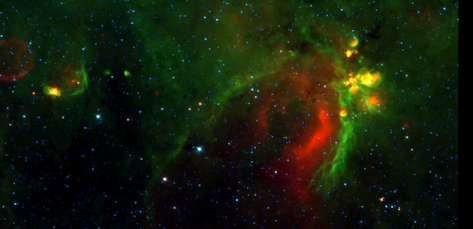Continuing this series of posts, answering questions from Milky Way Talk, here’s one from MWP user broomrider1970, who asked about a zoom option for the images. In fact there’s a whole thread about this on Talk.
When we first started planning the Milky Way Project (MWP) and began testing the interface, we actually had quite a lengthy discussion about a zoom option. In fact, digging through my email, it was my very first question to the developers. As it turns out, adding the zoom option is first of all quite challenging technically. Secondly, and more importantly, giving users the ability to zoom in on images gives us an extra level of uncertainty when we’re trying to process the classifications. By keeping the image static we know for sure that all the users saw the same image in the same way, and we know exactly what the minimum and maximum bubbles sizes are for each image. So it was really an issue of ensuring consistency in the classifications.
Next up: user chairstar asked:
Since I’ve found so many areas of interest – not just IDRC’s but other things like green knots, which do not have a round or square shape, I’d like to see if there is a way of allowing us to ACTUALLY drawing “lines” around irregularly shaped areas, as opposed to being constrained to the classic square and round shape that we are to use now.
Perhaps incorporating a drawing software, allowing free-hand lines could be put in.
Again, this is something we thought about. Particularly for the infrared dark clouds (IRDCs), which tend to have complex filamentary shapes, we wanted to have some kind of polygon- or freehand-drawing tool. But as with the zoom option, having freehand drawings as classifications makes it very challenging for us to merge all these drawings into a consistent catalog of objects. I’m also not sure how we would codify the information captured in freehand drawings in an easily accessible format.
In addition, for the specific case of IRDCs, it wasn’t clear that this would give us better results than an automatic detection algorithm. Several existing IRDC catalogs detected dark clouds with algorithms, and these actually do quite a good job. Not wasting people’s time on tasks that are done just as well by a computer is a core principle of the Zooniverse’s citizen science philosophy.


I have a comment about how the ZOO projects run. It’s something that I don’t think has occurred to you. if you will go through the comments that are on each Project you will find many complaints about NO FEEDBACK, NO ONE HERE, etc, etc.
YOUR SOURCE FOR THESE BLOGS comes from the zoo projects. And each project has a discussion, comment and chat function. YET **YOU** never participate in them. The users of these projects, the common people that participate and do the work EXPECT discussion but never get it.
I don’t think **YOU** get it.
I noticed that lots of similar questions were popping up in the Chat forums. So I thought it would be more efficient to answer them in a few blog posts, rather than answer each forum post individually. I’ll try to do some more soon. We get a little strapped for time to answer all the questions, but we’re really happy with the discussion.